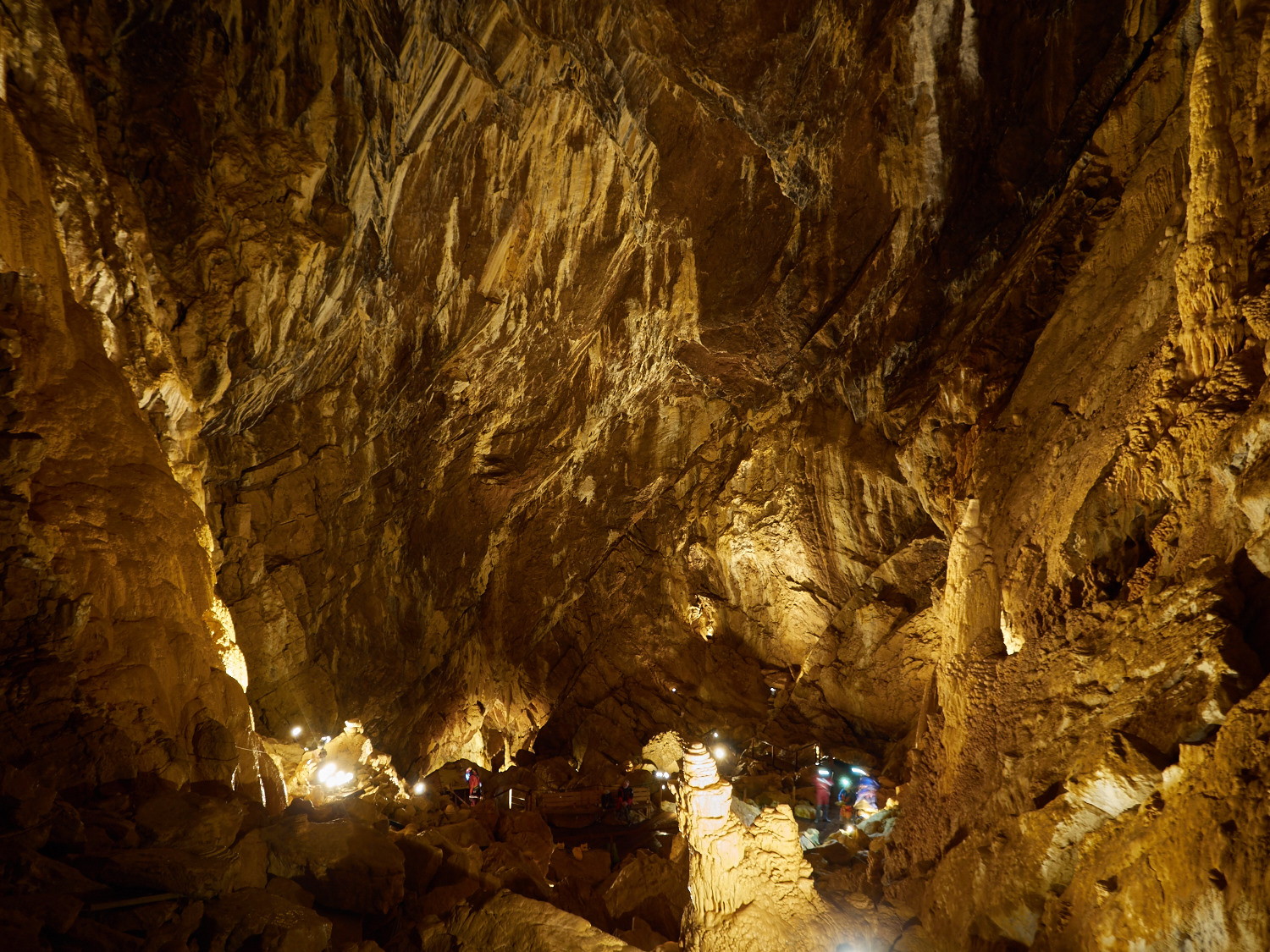
History of UIS Cave Rescue Commission (CRC)
The UIS Cave Rescue Commission (CRC) was founded as one of the first three Commissions of the UIS when it was established in 1965.
4th International Congress of Speleology was held in Postojna/Yugoslavia in 1965. During the General Assembly 23 countries decided the official establishment of the International Union of Speleology (UIS). One of the first three commissions was the Cave Rescue Commission. The proposal was made by Alexis de Martynoff and he was elected as the first president. The organization was headquartered in Belgium.
History of UIS Cave Rescue Commission (CRC)
Before UIS CRC

Caving as a sport started in the British Isles during the latter years of the nineteenth century but until the period between the World Wars it remained largely the preserve of a very few adventurers and scientists. During the 1920s and 1930s interest in caving grew, leading to the formation of the first caving clubs, initially in the Yorkshire Dales and in Somerset. Inevitably, the risks of cavers meeting accidents in places accessible only to fellow cavers increased in parallel. Although the new clubs had the means to cope with minor accidents, it became obvious that in the event of a serious incident a long way underground, the manpower and equipment available to any single club would be totally inadequate. This concern led to a pooling of resources and the formation of the Cave Rescue Organisation in Yorkshire, reputably the first in the world, in 1935 and the Mendip Rescue Organisation in Somerset in 1936.
1963 – Bruxelles and Han-sur-Lesse, Belgium
This was the first international meeting about cave rescue. 8 countries participated: England, Belgium, France, Lebanon, Luxembourg, Italy, Romania, Switzerland.
Next topics were discussed:
- necessity for caving leaders to be ready to carry out rescues themselves;
- involvement of the country where a rescue operation is being conducted;
- recognition of legal power;
- search for an adaptive stretcher;
- post-siphon rescue problems.
Establishment of the UIS CRC
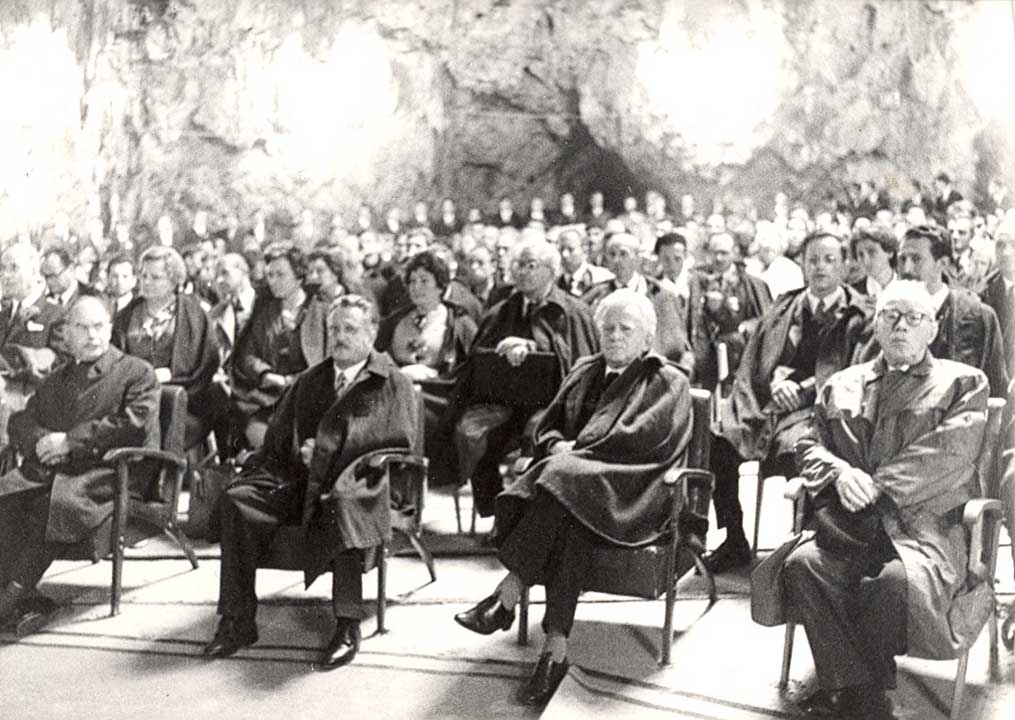
4th International Congress of Speleology was held in Postojna/Yugoslavia in 1965. During the General Assembly 23 countries decided the official establishment of the International Union of Speleology (UIS). One of the first three commissions was the Cave Rescue Commission. The proposal was made by Alexis de Martynoff and he was elected as the first president. The organization was headquartered in Belgium.
Key persons of UIS CRC
Alexis de Martynoff (1907-1985)

Alexis de Martinoff was born in Kharkow/USSR at 27 September 1907 and died in Bruxelles/Belgium at 25 April 1985. This good and generous man had a busy life. He was interested in everything related to nature and especially to the exploration of the underground world. In Belgium, during the creation of the Speleological Federation of Belgium, in 1952 founded the organization of Belgian Cave Rescue, which has already rendered so many services in the rescue of explorers in distress. His activity and the knowledge he has gained in this field, have earned him nomination as President of the UIS CRC. He had filled that position for 16 years between 1965 and 198. At the international level, he was one of the leader not only of the techniques of rescue in caves, but also of the prevention by teaching and education cavers.
Mike Meredith
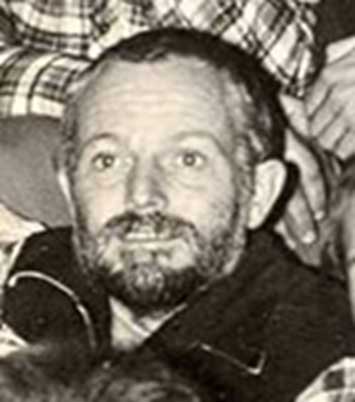
After 1981, when Martynoff resigned from his position, Mike was elected as president of UIS CRC. He was in that position until 1987. Mike was turned–on to caving with Burnley Caving Club. He then joined the staff of Whernside Caving Centre as Chief Instructor for three years before departing for France. Living in Grenoble he became a leading light in the Furets Jaune de Seyssins caving club. Later he became resident in Salzburg and continuing his caving in Austria. He had opportunity to study developments in caving technique in three countries. (Meredith, 1979). After 1987 he went into Malaysia where mostly concerned with park management, management planning and training of park staff. He became Vice-Chair of Biodiversity Conservation Society Sarawak.
André Slagmolen
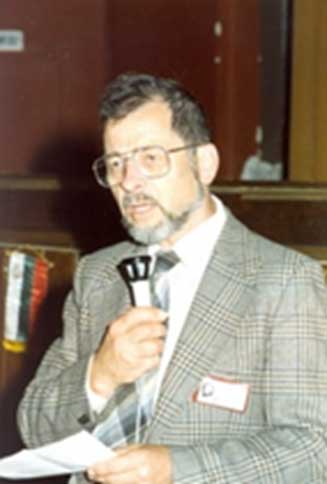
André Slagmolen (Belgium) was the secretary of the UIS CRC since 6th International Cave Rescue Conference held in Aggtelek/Hungary in 1983. He became the third president in Cividake/Italy in1987. André was one of the founder of the Belgian Cave Rescue in 1952. He died in 22 April 2007, just one month before the 11th International Conference held in Aggtelek again. All his live was devoted to the cave rescue. He had given time and energy to the proper functioning of underground rescue.
Christian Dodelin
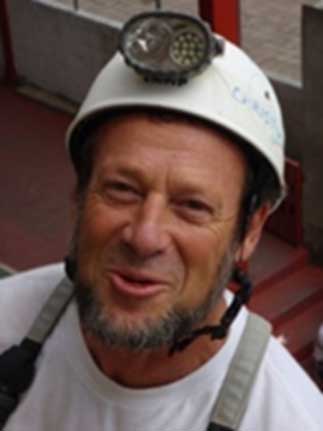
André Slagmolen transfers of his position to Christian Dodelin (France) in Athens/Kalamos (Greece) in 2005. Christian is caver since 1970, instructor at the French Caving School and he joined to French Cave Rescue (Spéléo Secours Français – SSF) in 1982. He participated of more than fifty rescue operations and he was president of SSF from 1996 to 2004. Leader of international cave rescue training since 1997. Participation to cave rescue training in other countries (Romania, Bulgaria, Greece, Belgium, Brasil, Argentina, Turkey, Mexico).
György Dénes (1923-2015)

Gyorgy Denes was father of Hungarian speleologists, prominent character of speleology in 20th century, honorary president of Hungarian Speleological Society, establisher of Hungarian Cave Rescue Service. Within the UIS CRC he was elected as secretary general in Zakopane/Poland in 1979, as vice president in Aggtelek/Hungary in 1983 and as honorary president in Aggtelek/Hungary 2007. Gyorgy DENES was born at 3 September, 1923. He graduated in law in Pecs University. He participated in reorganization of Hungarian Speleological Society in 1958, where he became secretary, secretary general and finally honorary president. He established the Hungarian Cave Rescue Service in 1961, which exist nowadays with high efficiency. He was member of presidency in Hungarian Geographical Society and in Hungarian Naturefriend Federation (HNF), president of Cave Commission of HNF. He was leader of uncountable cave research in different part of Hungary, but his favourite was the Aggtelek karst region. His scientific job was wide from karsthydrology through history to linguistics. His scholarship gave him opportunity to deal with ancient diplomas and found new knowledges. He was great lecturer and was ready to share his knowledges at all time. He has more than 300 publications in Hungary and abroad in different languages. He enjoyed the appreciation of cavers during his all life and additionally he received a lot of awards from state and governmental authorities of Hungary and foreign countries.
Gyula Hegedűs
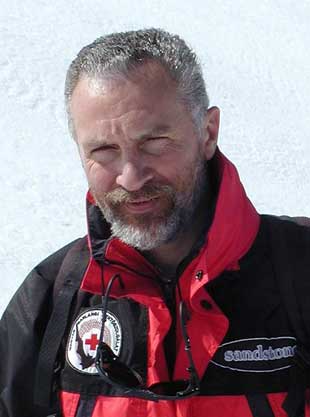
He started his career as a caver in 1972 and has been a member of the Hungarian Cave Rescue Service since 1974. He was primarily involved in the research of the vertical caves of Northern Hungary. In recent decades, he has visited the caves of almost all European countries, and he has also visited the caves of the USA, Canada, Cuba, and Australia. He held various positions in the Hungarian Speleological Society (HSS) as international secretary, committee member, disciplinary committee member, board member, and since 2020 the president of the HSS. He is a regular participant and speaker at international caving events. Between 2017 and 2022, he was a secretary of the Union Internationale de Spéléologie (UIS), and in 2022 he has been elected as president of the UIS Cave Rescue Commission.
Events of UIS CRC
One of the main preoccupations of the various presidents was to promote the information towards all the countries of the UIS. It has been decided to organize regularly, meetings, congresses or international conferences on the subject of the subterranean help.
Mozet, Belgium 1971
That second international meeting was held in Province de Namur, Belgium at 17-21 September, 1971. Participants had arrived from 16 countries as follows: Germany, England, Belgium, Bulgaria, Congo, Denmark, Spain, France, Greece, Hungary, Italy, Lebanon, New Zealand, Poland, Switzerland, Yugoslavia. That international meeting saw the evolution of concerns with techniques involved in cave rescue, including the presentation of the first cave stretcher by Dr Castin (France), and the demonstration of caving radio communication. Various presentations by national cave rescue organizations and a demonstration of a diving rescue were presented. Besides them legal problems, responsibilities and insurance policies were discussed. It was decided such an international meeting should be organized every four years, but not coinciding with that of alternating with UIS congresses.
Eisriesenwelt, Austria 1975
Representatives of 12 countries had participated from Germany, England, Austria, Belgium, Spain, France, Greece, Hungary, Italy, Poland, Switzerland and Yugoslavia. At this third meeting, the Commission made plans to create another Sub-Commission to develop a catalogue of safety materials especially developed for use in caves and rescue work. Technical contributions at that meeting included a demonstration with more than 9 stretchers and others ways to move injured people, as well as the first demonstration of removing obstructions in caves. The medical program included first meeting of cave doctors, led by Dr. Castin. Medical discussions was around first aid, cave diets and speed of intervention.
Sheffield, Great-Britain 1977
Next meeting of cave rescuers was held on the occasion of 7th ICS held in Sheffield/UK at 10-17 September, 1977. Many papers dealt with cave rescue and there were some practical demonstrations. Martynoff had taken an overview of the past and current activity of CRC. At that time 17 countries informed him that they have or are in the process of creating cave rescue services. Some countries (e.g. UK, Hungary, USA, Poland etc.) presented their organizations, activities and development of cave rescue equipments and techniques. Using 10 years of experiences the National Cave Rescue Commission (USA) together with UIS CRC developed a scoring system which would act as a measure of overall technical or the gross ability of a rescue service. The system count with emergency medical skills, training, team size, special skills, organization, mobilization and equipments as for communication and vertical caving, extraction and patient transportation tools.
Zakopane, Poland 1979
The 5th international conference was held at 2-6 October 1979. The participating countries were: Austria, Belgium, Bulgaria, Czechoslovakia, France, Germany, Great-Britain, Hungary, Italy, Portugal, USSR, Spain, United-States and Yugoslavia. The delegates gave information about their organizations and rescue jobs. Gyorgy Denes highlighted the importance of the prevention. Demonstrations were did by Bulgarian, Italian, Polish and Soviet cave rescuers. At the end of conference new directorate was elected for the next period. Because the CRC activity widened three new positions were created as vice-president to be responsible for different geographical areas.
So the elected directorate were as follows:
- Alexis de Martinoff (Belgium), President
- Daniel I. Smith (USA), Vice-president (American area)
- A. Efremov (USSR), Vice-president (East Europe area)
- Giuseppe Guidi (Italy), Vice-president (West europe area)
- Gyorgy Denes (Hungary), Secretary-general
- Petko Nedkov (Bulgaria), Pprevention
- Hermann Kirchmayr (Austria), Material
- Mike Meredith (Great-Britain), Technique
Aggtelek, Hungary 1983
The 6th International Cave Rescue Conference was held at 2-8 October 1983. More than 160 participants had arrived from 16 countries: Austria, Belgium, Bulgaria, Czechoslovakia, France, Germany, Great-Britain, Hungary, Italy, Portugal, Romania, United-States, USSR, Spain, Switzerland and Yugoslavia. More than 50 lectures were given about cave-rescue and communication equipements, methodology, first aid and other medical aspects, rescuer training, statistics on causes of accidents, organisation background of cave rescue, prevention of accidents and experiences of rescue operations. Rescue demonstrations were performed on the cliff at the entrance of Baradla cave by Hungarian, Austrian, Russian, French and Italian rescue teams. On the last day of the conference directorate election was held for next period as usually.
Its result were the next:
- Alexis de Martinoff (Belgium) was recognized as the founding president
- Mike Heredith (Great-Britain), President
- Gyorgy Denes (Hungary), Vice-presiden
- Hermann Kirchmayr (Austria), Equipement manager
- Pierre Rias (France). Technical manager
- Aurélio Pavanello (Italy), Statistics and prevention manager
- André Slagmolen (Belgium), Secretary and documentation manager
Cividale, Italy 1987
The 7th international conference was held in Cividale del Friuli near Trieste at 30 Aug – 5 Sept, 1987. The participating countries were: Austria, Argentina, Belgium, Czechoslovakia, Dominican Republic, France, Germany, Great-Britain, Greece, Hungary, Italy, Romania, Spain, Switzerland, USA and Yugoslavia. Program incuded:
- 9 medical presentation about pharmacy, medical actions, the administration of drugs and histoplasmosis;
- 12 technical presentations about various stretchers, cave-diving rescue, drilling material and the UIS catalog of materials;
- 18 presentations in prevention section about statistics of rescue operations and circulation of informations. (Urbain, 2011)
A discussion of the concept of cave rescue was conducted and there was a French presentation of some international rescue operations, as well as round-table conferences concerning diving, techniques and international relationships. Handling of a stretcher was demonstrated by an international team. A tribute to Alexis de Martynoff – who died in 1985 – was also presented. André Slagmolen (Belgium) was elected as president and Gyorgy Denes (Hungary) as vice-president. The elected commission members were Edith Bednarik (Austria), Alejandro Tellez Gottardi (Spain), Trifon Daaliev (Bulgaria), Ercillio Vento Canosa (Cuba), Vladimir Pashovsky (Bulgaria), José L. Menjibar Silva (Spain), Bernard Urbain (Belgium).
Budapest, Hungary 1989
That meeting was the pre-congress event of the 10th ICS held at 9-13 August 1989. Participants nuber were 143 who had arrived from 21 countries: Australia, Austria, Belgium, Bulgaria, Canada, Czechoslovakia, France, Germany, Great-Britain, Greece, Hungary, Italy, Norway, Poland, Romania, Spain, Switzerland, Sweden, USSR, Venezuela and Yugoslavia. 13 lecturer presented 18 presentations and there were 15 practical demonstrations. Most imporant session dealt with medical aspects of cave rescue when 12 medical doctors sat around the table from 7 countries. A common cave rescue exercise was also organized in which a large majority of participants took part. The participants showed the possibilities of solving problems in a cave in practice.
Following the meeting of the commission composed were as follows:
- André Slagmolen (Belgium), President
- Gyorgy Denes (Hungary), Vice-president
- Edith Bednarik (Austria), Secretary
- Alejandro Tellez Gottardi (Spain), Secretary
- Trifon Daaliev (Bulgaria), Secretary
- Ercilio Vento Canosa (Cuba), Secretary
- Vladimir Pashovsky ( Bulgaria), medical sub commission
- Jean-Louis De Bock (Belgium), documentation
- Bernard Urbain (Belgium), History
- Alession Frabbricatore (Italy), Member
- Walter F. Gutt (Romania), Member
La Chaux-de-Fondes, Switzerland 1997
That event was organized as part of the 12th ICS at 10-17 August 1997. The presentations dealt with next: cave accidents in France, cave rescue in Switzerland, histoplasmosis, waterproof stretcher for divers rescue, victim’s assistance and epidemic dangers in the caves of Middle Asia. During the commission meeting Gyorgy Denes (Hungary) was relieve of his function of vice-president and replaced by Trifon Daaliev (Bulgaria) and Grace Matts (Australia). Efrain Mercado was named as regional coordinator for the Federación Espeleológica de América Latina y del Caribe (FEALC).
Sart-Tilman, Belgium 2002
The 10th International Cave Rescue Conference was held in Sart-Tilman near Liège/Belgium at 1-3 November 2002. It was organized on the occasion of the 50th anniversary of the establishment of Belgian Cave Rescue (Spéléo-Secours Belge). There were 117 participants from 14 countries as follows:, Austria, Belgium, Corea, Cuba, France, Germany, Great-Britain, Hungary, Japan, Luxembourg, Morocco, Poland, Switzerland. USA. About 40 lectures were presented on the next topics:
- cost of cave rescue operations and interest of a cave rescue team,
- presentation of some rescue operations,
- medical presentations, histoplasmosis,
- passage widening with Hilti cartridge,
- cave ventillation,
- round table with international interventions as subject.
Aggtelek, Hungary 2007
11th International Cave Rescue Conference was held between 15-18 May 2007. 83 participants were there from 26 countries on: Austria, Belgium, Bosnia-Hercegovina, Bulgaria, Croatia, Spain, France, Germany, Great-Britain, Greece, Hungary, Italy, Japan, Lebanon, Mexico, Montenegro, Norway, Poland, Puerto Rico, Czech Republic, Romania, Serbia, Slovakia, Slovenia, Sweden, USA. 38 papers and video reports and demonstration were presented about next main topics:
- organizational aspects of cave rescue,
- contributions of cave rescue squad for civil protection during disaster,
- medical aspects of cave rescue activity,
- cave rescue educations and trainings,
- equipments, technics and radio transmission demo,
- different serious rescue operations in different countries.
Next key persons of UIS CRC were present:
- Gyorgy Denes, Honorary president
- Christian Dodelin, CRC president
- Gyula Hegedus, Organizator of the 11th conference
- Efrain Mercado, Webmaster
- Trifon Daaliev, Balkan countries correspondent
- Satochi Goto, Asia correspondent
- Badr Jabbour Gedeon, Minor Asia correspondent
- Bernard Urbain, Administration and history of CRC
Aggtelek Agreement were created by representatives of the 26 countries present at the 11th international UIS Conference of Cave Rescue support certain basic recommendations concerning cave rescue operations. Its focus is to give basic fundamentals to form rescue teams which are legally approved and supported by states. This speleological federations validated document may serve as support in negotiations between rescue managers and administrations.
Dryanovo, Bulgaria 2011
The 12th International Cave Rescue Conference was held in Dryanovo Monastery/Bulgaria at 8-15 May 2011. More than 100 cavers participated and 58 had arrived from abroad from 15 countries: Bulgaria, Croatia, France, Great-Britain, Hungary, Italy, Lebanon, Puerto Rico, Romania, Russia, Serbia, Slovenia, Spain, Ukraine and USA. 24 papers and 2 demonstration were presented. Main scopes were:
- new rescue techniques on rock wall,
- new rescue techniques in cave,
- equipment presentations,
- new rope techniques demonstrations,
- medical demonstration,
- diving demonstration,
- new diving equipment for rescue and
- communication in caves.
Some lectures were highlighted in the presentations: research on the “sit harness syndrome,” work-related hypothermia, evidence of the usefulness of cooperation. Italians presented their activity at an earthquake.
Vaumarcus, Switzerland 2015
The 13th International Cave Rescue Conference was held in Le Camp-Vaumarcus/Switzerland at 13-19 April 2015. 110 cavers participated from 14 countries as Austria, Belgium, Bulgaria, Canada, Croatia, France, Germany, Hungary, Italy, Netherlands, New Zealand, Russia, Slovenia and Switzerland.
There were 32 presentations about:
- equipment tests;
- introduction of cave rescue services of different countries
- European Cave Rescue Association (ECRA);
- EU Civil Protection Mechanism
- medical session was open to physicians, paramedics, first-aid specialists. There were presentations and discussions on medical gears (suitable for underground rescue);
- one session devoted to testing stretchers among the different teams who brought them;
- diving rescue was addressed to rescue beyond siphons. This type of intervention requires diving through totally submerged passages that are impossible to pump out, before accessing the victim;
- prevention and training session pondered how to deliver a message of caution without giving up the joys of discovery and exploration. There were discussed experiences of trainings and rescue operations;
- emergency medical assistance by air and there were a practical demonstration about collaboration with helicopter.
Sydney, Australia 2017
Only a short meeting was held in 2017 during the 17th ICS, in Sydney, Australia.
Reorganization of UIS CRC
There were no other activities since that time due to the long illness and the death in 2021 of Chris-
tian Dodelin, who was then President of the Commission. It was at this time that UIS decided to reorganize such an important commission and a meeting was held in July 2022 during the 18th ICS in France, where we also scheduled a Cave Rescue Symposium. At that symposium, those present agreed on the importance of reorganizing the commission and elected Gyula Hegedűs as President to lead on this work.
The first task is to re-build the relationships with the rescue organizations in the UIS member countries and to re-establish communication channels between all, by organizing a mailing list, homepage, etc. Besides them, we will join efforts on the organization of the 14th International Cave Rescue Conference (ICRC), which will be held in Spain in 2024.
